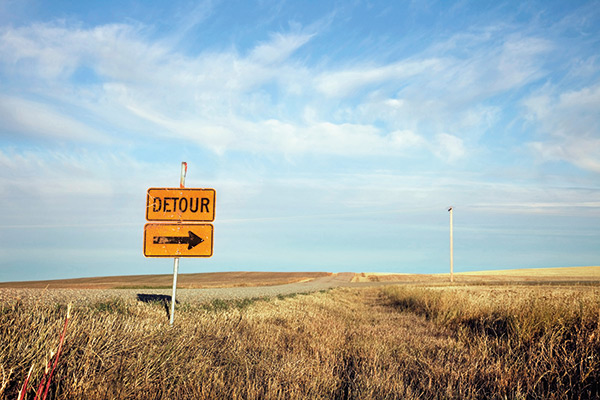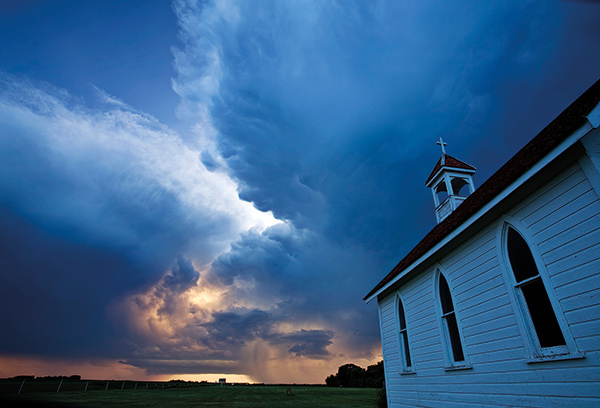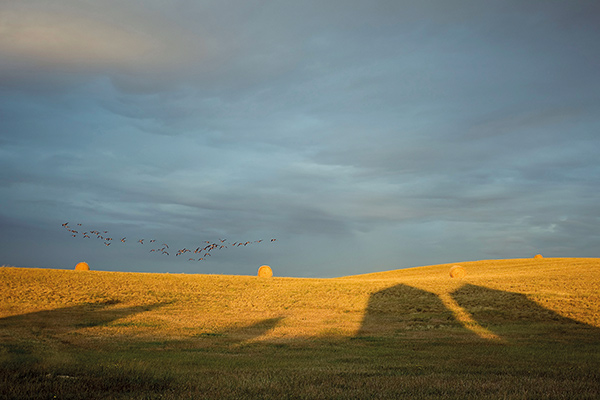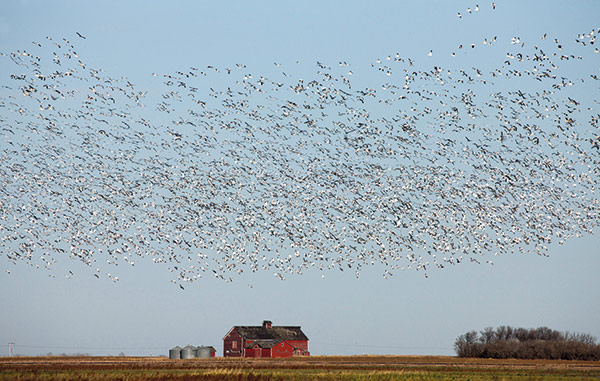Subtotal: $
Checkout-

The Plants Can Talk
-

Saving the Soil, Saving the Farm
-

The Wonder of Moths
-

The Leper of Abercuawg
-

Dandelions: An Apology
-

A Wilderness God
-

Why I Hunt
-

Reading the Book of Nature
-

Breakwater
-

Lambing Season
-

Earthworks Urban Farm
-

Are You a Tree?
-

Practicing Christianity
-

Who Gets to Tell the Story?
-

A Medievalist Looks for the Image of Christ
-

In Defense of Chastity
-

Poem: “Let Them Grow”
-

Poem: “Squall”
-

Readers Respond
-

GEDs for Myanmar Migrants
-

Inside Nyansa Classical Community
-

Watching the Geminids
-

A World Full of Signs
-

Covering the Cover: The Riddle of Nature
-

Back from Walden Pond
-

Can Masculinity Be Good?
-

Nature Is Obsessed with Me
-

Ancient Songs in the Desert
-

The Sadness of the Creatures
-

Meeting the Wolf

Saskatchewan, Promised Land
A newcomer to the Canadian prairie searches for the Old Testament promise.
By Daniel J. D. Stulac
March 1, 2024
Available languages: Deutsch
I am standing in a graveyard at the edge of town. The calendar reads November 1, but winter has already arrived in earnest. I scan the horizon, hoping to glimpse a ripple or a bump – any aberration – in the desolate expanse I now call home. My pupils widen, but the inescapable currents of air curl behind my glasses and I must look away. Infinite blue overhead; endless snow underfoot. Like radio static, ice crystals blow through the remnants of last summer’s wheat. Wind, wind, wind. It seems to scour the whole world down to white slate.
Why on earth am I here? I am certainly not from here. Vocation, I tell myself. The mission of the Christian college where I now teach the Old Testament. Desperation, more like it. I have not chosen to relocate to a tiny town on the Canadian prairie inasmuch as my culture has relocated me. The tenets of modern industrialism conspire to uproot me, to “de-place” me, to keep me sliding around the planet as if it were a greased ball bearing. Twenty-five years of reading Wendell Berry and I’m still just another cog in the machine I purport to resist. I’ve moved (yet again) to take a white-collar job in academia. New people, new laws, new culture, new soil, new climate – all for a job. At forty-five, I am running out of time. Rooting in a place can take decades, and I have only so many decades to spare. Perhaps I should interpret Saskatchewan’s mind-numbing flatness as karma for my obvious hypocrisy.

Rural Saskatchewan road. Photograph by McMaster Studio / Alamy Stock Photo
Highway signage welcomes newcomers to Saskatchewan with the slogan: “Land of Living Skies.” “Don’t look down,” the marketing specialists in Regina seemed to whisper in my ear as I first lumbered across the border in a twenty-six-foot-long U-Haul. “You’ll be disappointed if you do.” Spend your money. Build the economy. Invest in potash, dirty oil, or big ag. Probably best, however, if you flick on the TV at night and imagine that you are anywhere but here.
How does one settle down while looking only up? Where’s the promise in a land like this?
Old Testament Studies
Some say that Christianity licenses the unbridled exploitation of the planet, that it promotes apathy and disinterest in the material world in a way that other, earth-friendly, place-based religions do not. Christianity, they say, focuses the believer on the great hereafter, encouraging him or her to think only about leaving our space rock behind by escaping into heaven, rather than cultivating deep attention to the soil and land underfoot. The religion’s inherent portability – its capacity to spread anywhere in the world – suggests that in general Christians are less attached to place.
These claims have attracted many rebuttals, including my own. We need a better understanding of scripture, a more nuanced approach to history, and fewer unfounded assumptions. I am right, I tell myself. And yet my arguments remain intellectual. When do the principles I promulgate finally move from my brain to my body, from thought into action? When will I practice what I preach?
Today I am leading another session of BLST 423 Advanced Hermeneutics. My deep background on the subject of Promised Land feels to me as solid as a rusty weathervane bending before a stiff prairie gale. As my students and I wander through modern questions concerning a literal Exodus from Egypt and the subsequent conquest of Canaan, I lead them to the New Testament. Israel’s inhabitation of Canaan, I explain confidently, points beyond itself. Its material historicity alone does not account for the text’s theological horizon. Books of the Bible such as Isaiah gesture in precisely this direction, and so provide a rationale for the spiritualizing tendency that seems to define Christianity’s appropriation of Old Testament scripture and from which it may never escape: Don’t worry about the past; look to the future! (Isa. 43:18–19). Try telling that to a modern citizen of Israel, where archaeology attracts hordes of volunteers who pay for the privilege of touching the land’s recently excavated past. In comparison, my faith goes anywhere, like a feather on the breeze. My religion moves.
If the Exodus amounts to a literary paradigm, and the conquest of Canaan is a theological metaphor, does anything remain of the Promised Land as a material place? Perhaps industrialism so thoroughly uproots us because Christianity first engineered a radical divorce between people and the earth. Is the gospel intrinsically, unavoidably, landless? After all, I am here in Saskatchewan, living on stolen territory, because I heard the voice of Jesus calling.
Prairie Dust
Not long after our arrival in Saskatchewan, my wife and I became regular attenders at the local Anglican church. Amid prayer requests and news pertaining to our community of white Canadians and recent immigrants from around the world, St. Aidan’s weekly bulletin informs me that I worship “on Treaty 4 Territory, the traditional lands of the Cree, Ojibwe, Saulteaux, and Dakota.” While entirely supportive of the point, I remain unsure what the virtue signaled by these words accomplishes on the ground itself. Does the reminder somehow help our community to become more attentive to this place than we might otherwise be? I see little evidence that such statements slow down the invasion. If a new homeowner on the edge of town, carving out a little more of the surrounding prairie as his own, were to appear in the pews one Sunday morning, we would welcome that parishioner with open arms and no questions asked. After all, Jesus taught us that sinners should not cast stones (John 8:7).

Storm clouds over a Saskatchewan country church. Photograph by McMaster Studio / Alamy Stock Photo
Becoming rooted in a place is tricky business, now more than ever in a world supercharged with racial awareness, and on geography defined by centuries of colonization. Ubiquitous shame has made us a continent of Pharisees who seem no nearer to solving our problems than the sinners who preceded us. I have no recourse but to turn my eyes downward, to the earth underfoot. I will begin again, at square one. I will begin with earth, for I was made from dust, and to dust I shall return (Gen. 3:19).
Saskatchewan’s aridity surprises me. The air wicks my garden dry, and I find myself drawing from the roof-water collection tanks even as the growing season gets underway. The soil here feels powdery to the touch, like dry meringue. I am more familiar with gritty, East Coast custard. Fieldstones, meanwhile, seem to be as rare as arrowheads. My shovel cuts an easy furrow. The scuffle hoe slips effortlessly between the starts. No wonder the pioneers assumed they had reached the Promised Land!
When our chores are done, my daughters and I wander past the unfenced property line to fly a kite in the public meadow beyond. The activity requires so little effort that the tie-dyed object dancing above our heads begins to bore me almost immediately. As the girls take turns holding the spool, I sit down behind them on a bed of unfamiliar vegetation. Back in New Hampshire, I would know all the names: white pine, sugar maple, red oak, paper birch, and balsam fir. In North Carolina, I became a pro: redbud, beech, dogwood, hickory, and loblolly pine. Casting me upon the plains, Christian mission has robbed me of my local knowledge and expertise. Surely the plants here – bluegrass, switchgrass, Indiangrass – all have unique personalities, but I cannot tell them apart. Jesus has me starting over again as a child: feet buried in grasses I do not yet understand, eyes fixed on wind because I have nowhere else to look.
Torah Class
The land is a gift (Deut. 4:1). It cannot be grasped; it can only be received. It’s not a territory to be conquered and claimed. Not a resource to be excavated and exploited. Not a virgin to be defiled and discarded. Israel inhabits the Promised Land only by adopting a posture of sheer, unadulterated dependence, by relying on daily deposits of heavenly bread. Trudging down dry wadis and out over pebble-strewn expanses, God’s people feel the desert in every cracked heel and in every open blister. They do not simply pass through it; they undergo it, and those forty years – approximately the length of my own life thus far – remain a crucial component of the homecoming they eventually enjoy. Tattered sandals scraping over dust and gravel; eyes trained to a pillar of cloud by day and a dazzling sunset every night (Exod. 13:21). When I trekked the Negev for myself, as a graduate student, I left my camera on its panoramic setting. There too is a land of living skies.

Canada geese fly over a southern Saskatchewan grain field. Photograph by McMaster Studio / Alamy Stock Photo
Why do the Israelites find the Promised Land so difficult to reach? My students wonder aloud how anyone in their right mind could fail so miserably to obey God after witnessing the Red Sea crossing in Exodus 14, or after eating manna and drinking from miraculous streams along the way. Why don’t the Israelites “get it”? After two or three weeks devoted to the text, the story cannot help but read as a farce, as a caricature of Israel’s quest to differentiate itself from its patient but holy God. And yet I wonder if the plot is really so implausible. The historical parameters may have changed, but I too find it strangely difficult to subsist on daily bread, and to collect only as much as I need. I too have trouble accepting gifts. Something about rooting requires me, ironically, to turn up my eyes, from the soil below to the embers glowing on the horizon beyond.
Prairie Pests
Nothing drills home creation’s fallen nature like an infestation of flea beetles. They invade my garden in numbers I had previously reserved only for a biblical plague. I try pinching. I try pepper. I try prayer. Nothing works. In less than forty-eight hours, the tiny insects decimate my kale and eat my arugula sprouts down to tiny nubs. I once fancied myself an agricultural educator, but here on the prairie I discover what a novice I really am. After the damage has already been done, I swallow my pride and ask around at school and at church. Longtime residents reply to my inquiry with loving smirks. Oh yes, I am told, it’s far too late in the season for kale.
Give us this day our daily salad, Lord. In the meantime, I will scratch a living from the thorns and the thistles, the hornworms and the cabbage moths. I suppose the ground is cursed (Gen. 3:17–19), but I will try again next year anyway. And next time, I will ask my neighbors first. I will respond to the place instead of insisting that the place respond to me.
The Acts of the Apostles
How does the Christian story train Jesus’ disciples to live in – and as – creation? What do soil and land mean in the Christian imagination?
Certainly the Torah’s idea of Promised Land, insofar as it embodies Sabbath rest, amounts to something more than a material, geographical, and historical category. But the fact that Promised Land points beyond itself – that it looks toward a spiritual and an eschatological horizon – does not mean that we must swap out the tangible for an abstraction. In the Bible, the material and the spiritual are not mutually exclusive categories. The new heavens and the new earth of Isaiah 65, for example, do not unfold in an alternate universe. Rather, Israel’s hope takes shape through the renewal of this world, a world in which human beings continue to work, build, eat, play, and love. In other words, the biblical idea of land does not mutate through Christ into better psychology and an improved attitude. Rather, it encompasses both what is seen, touched, and felt and that which remains unseen, anticipated, and inferred. No, Christians do not await cloud nine. We await, in the words of the Apostles’ Creed, the “resurrection of the body.”
Something about rooting requires me, ironically, to turn up my eyes, from the soil below to the embers glowing on the horizon beyond.
If Matthew, Mark, Luke, and John proclaim the good news of Jesus Christ, the Book of Acts can be thought of as proclaiming the good news of the Holy Spirit. It tells the story of the church’s explosion into the world outside Jerusalem. Crucially, the people who undertake missionary ventures in this text do so not as conquerors but as servants of the Wind that precedes them, as if following a pillar of cloud and fire from Judea to Antioch and into the Gentile world beyond. An angel guides Philip (Acts 8:26) into an unexpected conversation, and so the gospel goes to Ethiopia. Another angel, in the port city of Caesarea, directs Cornelius to contact Peter (Acts 10:3–6). The same Wind prevents Paul from preaching in Phrygia and Galatia, but opens a door into Macedonia, and so the gospel flows freely into Europe (Acts 16:6–10). In all these cases, the Spirit goes first, and likewise, in all these cases, the Christians involved proclaim the resurrection of the body, not a detachment of the soul.
The Book of Acts suggests that Abraham’s children can pop up just about anywhere. Among Jews, certainly, but also among Greeks. White or black, slave or free, Native American or African immigrant – this unpredictable Wind does not discriminate. In the same way, the Book of Acts implies that Abraham’s home – God’s material promise to Israel – may be found from pole to pole. Whether a person lives in a South American rainforest, or on the Mongolian steppe, or in the outback of central Australia, rooting in a place remains an ever-present possibility, for in Christ all land is holy land. All land is a promise. All land is a gift.
Does Christianity sever humans’ relationship with the earth? On the contrary, the Book of Acts – the Gospel of the Holy Wind – is “land-some” to its core. Jesus does not “de-place” me; rather, he “all-places” me – if and only if I remain dependent on the One who feeds me daily bread. If and only if I remember to look up.
Prairie Skies
Fall returns and, in an El Niño year, persists longer than it should. I am simultaneously distressed about global climate change and grateful for the unseasonable warmth. Hypocrisy never goes away entirely in a broken world.
Saskatchewan reveals a surprisingly textured landscape if one knows where to look. I have begun to explore the Coteau Hills on the southern horizon, as well as the shallow creek beds and forest pockets outside of town. A leap over the barbed-wire fence just beyond the dump leads to a game trail. Twenty gray partridges explode into view, wings beating like those of hummingbirds. They are immigrants, like me. Perhaps that is why they remain so skittish, foraging in their home away from home. I follow the path, hoping to see one of the coyotes that keep me awake at night. Maybe a badger, or a fox. Some twenty minutes later, I find myself standing at the edge of a small bluff, looking down on an aspen grove beside a pond dotted with teals, shovelers, pintails, canvasbacks, and mallards. A great blue heron stands among the rushes at water’s edge. A harrier flies low over the field beyond. Wind funnels up through the coulee, whipping the long prairie grasses back and forth like ocean whitecaps. A Swainson’s hawk rides the draft and disappears over the hill, as if purely for pleasure.

A flock of snow geese in Saskatchewan. Photograph by McMaster Studio / Alamy Stock Photo
A few weeks later I am sitting on my deck, watching my daughters climb the apple tree in our backyard. Crisp autumn air calls for sturdy jackets, but, knowing that deep winter will soon arrive, we milk the season for every drop of outdoor fun. Before long, I notice something brewing on the horizon and worry that the wildfires in British Columbia and Alberta will soon drive us all indoors. The “smoke” grows larger – massive, flowing, fluctuating, airborne currents, as if the sky’s own fabric were folding over on itself. “Girls,” I say, “come down from the tree and have a look.” They register adventure in my voice and quickly follow my lead. Before we know it, a multitude of the heavenly host appears above us, praising God and saying …
“Birds!” cries Abigail, and she is right. Canada geese and snow geese, in mixed flocks of a size I had not imagined possible. Not hundreds, not thousands, but tens of thousands, even hundreds of thousands. They ripple by in wave after wave after wave. I could never grow bored watching this. “The sky,” says Abigail, gasping. “It’s … it’s … alive!”
One year has passed, and again I find myself standing in the graveyard at the edge of town. Winter has returned, and I am bundled to the brim. I scan the horizon, waiting for the full moon to rise into the purple canvas above. As my pupils widen, the breeze curls behind my glasses as usual, but I do not look away. Like children laughing, ice crystals blow through the remnants of last summer’s wheat. Wind, wind, always wind. I hold my arms aloft, drawn by the Spirit. My toes grip the earth below. I am dust. I am soil. I am made of daily bread. I am material creation. And I am convinced that here, too, is Promised Land.
Already a subscriber? Sign in
Try 3 months of unlimited access. Start your FREE TRIAL today. Cancel anytime.










































Nicolai Hansen
Years ago there as a TV show, “Corner Gas”, that took place on the Canadian prairies. Two of the residents are sitting on a car looking out over the prairie. A non-resident comes by and says, “I can’t see anything!” One of the residents replies, “No, I can see everything.” Thanks for your, “I can se everything perspective.
Doug Reichel
Ah, Daniel. You have so eloquently captured the journey from adult (jaded?) comparisons -"desolate expanse"- to child-like acceptance and wonder -"the sky.....it's alive!". Mountain grandeur gets more promotional leverage than Plains plainess. Both have a starkness. But if the choice is made to actually engage and not virtually escape life on the Prairies, then one has the opportunity, over time, to have our lust for the spectacular purged by the subtle and the nuanced. Thank you, Daniel, for attending so thoughtfully to this part of the planet you and your loved ones now call home.
Mardi Baron
"...The book of Acts; the Gospel of the Holy wind..." Oh, I am committing this to my heart! It so perfectly describes my whole beings reaction to Paul's work. Thank for this beautiful reflection. As a native Montanan, I believe Saskatchewan to be a kindred spirit.